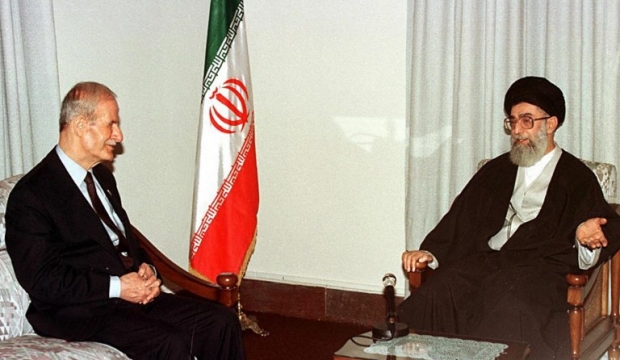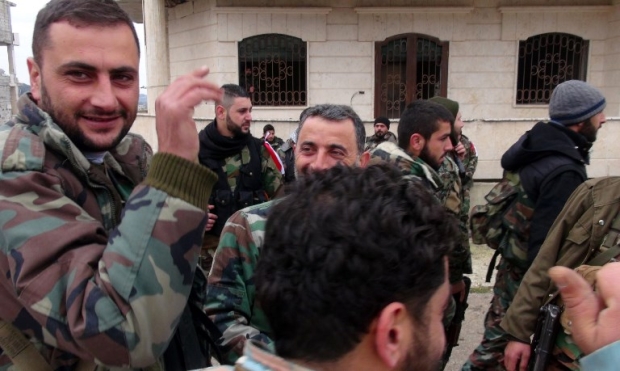Birth of a second Hezbollah? Where Iran stands in a post-war Syria

Shortly after the Iranian Revolution in 1979, the two regimes in Tehran and Damascus forged an enduring alliance that superseded the fundamental differences dividing the two states, including the debates of Arab versus Persian and secular versus Islamic.
What solidified the nascent alliance between the two states was a mutual threat posed by three daunting enemies
What solidified the nascent alliance between the two states was a mutual threat posed by three daunting enemies: Iraq, at the time ruled by Saddam Hussein, Israel, and the United States.
In 1980, Iraqi forces invaded Iran. During the war (1980-1988), Syria, then led by Hafez al-Assad, Bashar al-Assad’s father, was the only Arab country that stood by Iran.
In April 1982, in a glaring sign of support of Iran, Syria shut down the Kirkuk-Banias pipeline which had previously, at its peak, delivered 1.2 million barrels of Iraqi oil for export each day. The move left the Iraqis with only 650,000 barrels of crude exported each day.
Why is Syria vital to Iran?
A hostile position toward Israel is one of the pillars of Islamic Iran’s foreign policy. This enduring hostility has deep religious, historical, political, and socio-psychological roots.
In the 1980s, the Iranian Revolutionary Guards (IRGC) funded, organised, and trained Shia forces in Lebanon under the Hezbollah banner. The objective was three-fold: to change the balance of power in favour of the Shia community in Lebanon, to use Hezbollah as a deterrent force against Israel if it decided to begin a war against Iran, and to confront the unchallenged hegemony of Israel in its proximity.
The doctrine proved a success: in the 2006 asymmetric war between Israel and Hezbollah, the latter emerged as the only Arab military power who could counter Israeli aggression.
As a result of a strategic American mistake involving Iran’s staunch foe, Iraq, Saddam Hussein’s regime collapsed. The mistake brought to power certain opposition Shia groups that were weaponised, trained and funded for years by Iran. This development suddenly expanded Iran’s sphere of influence and connected Tehran to Hezbollah in Lebanon through Iraq and Syria almost unobstructed.
Keeping Assad in place
Eight years later, as part of the pro-democracy upheavals in the Arab world, the so-called Arab Spring protests erupted in March 2011 in Syria. The uprising against the dictator, Bashar al-Assad, rapidly transformed into a bloody proxy war that drew in regional competitors and world powers.
Iran’s doctrine in Syria and Iraq is that 'if we don’t defend our strongholds outside of our borders we will have to fight our enemies inside our borders'
The Iranian ruling system was threatened not only by the rise of the brutal anti-Shia Islamic State (IS) group, but also by potentially losing Syria to its radical Sunni competitor, Saudi Arabia, which has reportedly, since the summer of 2013, been the main player financing and arming the rebels fighting Assad's regime. Assad’s collapse would have also have been a monumental blow to Iran’s strategic depth and thus its deterrent power against Israel.
Iran’s doctrine in Syria and Iraq is that "if we don’t defend our strongholds outside of our borders we will have to fight our enemies inside our borders”. Accordingly, Iran heavily invested in Syria. Staffan de Mistura, UN special envoy for Syria, has previously estimated that Iran spends $6bn annually in the Syrian war.
According to IRGC officials, the largest Iranian contribution has been the organising of the National Defence Forces (NDF), a pro-government militia. According to several independent reports, at any given time, there are an estimated 50,000 National Defence Force fighters under arms in Syria.
In addition, numerous reports confirm that the Fatemiyoun Brigade - composed of thousands of Afghan Shias who fight under the auspices of Hezbollah Afghanistan, the Zaynabiyoun Brigade (the Pakistani version of Fatemiyoun), Hezbollah of Lebanon, and the militia group Kataib Hezbollah of Iraq - are actively involved in the Syrian war under the Iranian IRGC’s direct control.
A second Hezbollah?
Modelled after the Lebanese militant group Hezbollah and the experience of coordinating with proxy militias in Iraq, this large, battle-hardened paramilitary base in Syria will provide assurance to Iran by emerging as a decisive political force in Syria once the war is settled, no matter which government is in power as it happened in Lebanon and Iraq.
This simply means the birth of a second Hezbollah and an Iranian foothold right in Israel’s backyard with Syria.
It was against this backdrop that, at Israeli Prime Minister Benjamin Netanyahu’s request, Russian President Vladimir Putin met with him on 23 August. Speaking after his meeting with Putin, Netanyahu said Iran is trying to "Lebanonise" Syria and take the country over using Shia militias.
According to several reports, Mossad intelligence agency chief Yossi Cohen provided Putin with “sensitive, credible and very disturbing detailed intelligence” regarding Iran’s military presence in Syria during the meeting. After the meeting, Netanyahu said that he told Putin “that Israel was willing to act to prevent a continued Iranian military presence in Syria”.
He added, “When we have done this in the past, we did not ask permission but provided an update on what our policy is. … The international community knows that when we say something, we also carry it out.”
Here to stay
But will Iran leave Syria after investing years of blood and resources in the country simply because of Israeli threats? Of course not.
According to Rami Abdurrahman, the head of the Syrian Observatory for Human Rights, “it is almost impossible to prevent Iran from achieving its goal, after it spent hundreds of millions of dollars and sent arms and fighters to help keep Assad in power … Iran's influence in Syria is unstoppable even if Bashar Assad leaves power because Iran has deep links and presence in Syria.”
Can Russia come to Israel’s aid and push Iran to leave Syria? Unlikely
Israel has carried out several hit-and-run strikes on Iran-backed forces and their caches of weapons and ammunition, but hasn't taken responsibility for most of the operationally limited attacks publicly.
A full-fledged war against Iran-backed forces in Syria could potentially expand to an all-out war between the two states. Iran, despite constant heated rhetoric against Israel, is extremely cautious and seeks to avoid such an outcome. So too with Israel, despite its tenacious saber-rattling against Iran.
Israel has serious limitations if it wants to go to war against Iran, according to Major General Yair Golan, who served as deputy chief of staff in the Israeli military until May 2017. “We cannot fight Iran alone,” he said during a speech at the Washington Institute for Near East Policy earlier this month. Israel, he added, would need the US military to confront Iran if hostilities broke out in the future.
As with its mastery of Lebanon and Iraq, Iranians will be a decisive political weight in the future of Syria with or without Bashar Assad.
Can Russia come to Israel’s aid and push Iran to leave Syria? Unlikely. Russia’s alliance with Iran under the geopolitical status quo, which is likely to perpetuate into the foreseeable future, is deep and strong. Among several other reasons, there is a powerful common interest: the two states fundamentally reject US hegemony.
- Shahir Shahidsaless is an Iranian-Canadian political analyst and freelance journalist writing about Iranian domestic and foreign affairs, the Middle East and US foreign policy in the region. He is the co-author of Iran and the United States: An Insider’s View on the Failed Past and the Road to Peace. He is a contributor to several websites with focus on the Middle East as well as the Huffington Post. He also regularly writes for BBC Persian. You can reach him at [email protected] or follow him on Twitter @SShahisaless.
The views expressed in this article belong to the author and do not necessarily reflect the editorial policy of Middle East Eye.
Photo: A Syrian van with a poster of Hezbollah leader Hassan Nasrallah and Syrian President Bashar al-Assad covering its window arrives at Masnaa, the Lebanese-Syrian crossing border in the Bekaa Valley (AFP)
This article is available in French on Middle East Eye French edition.
Middle East Eye propose une couverture et une analyse indépendantes et incomparables du Moyen-Orient, de l’Afrique du Nord et d’autres régions du monde. Pour en savoir plus sur la reprise de ce contenu et les frais qui s’appliquent, veuillez remplir ce formulaire [en anglais]. Pour en savoir plus sur MEE, cliquez ici [en anglais].





